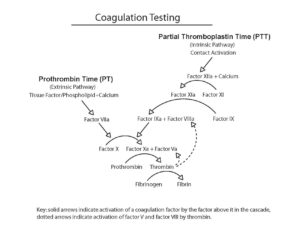1. The first is the physiological coagulation cascade, which is used to describe a very complex step-by-step process that occurs in the body (in vivo) when a blood vessel is injured. Several special proteins known as coagulation factors are activated one after the other in a “cascade” effect. The end result is a blood clot that creates a barrier over the injury site, protecting it until it heals. This process also involves a feedback system that regulates clot formation in the body so that clots are removed when the injury site is healed.

2. The second definition refers to the series of protein (coagulation factor) activations that occur in vitro when coagulation testing is performed in the laboratory. A sample of blood is tested by adding substances that begin the coagulation process, and the time that it takes for the sample to begin to clot is measured. The PTT measures those protein factors that are part the cascade often referred to as the intrinsic and common pathways: XII, XI, IX, VIII, X, V, II, and fibrinogen as well as prekallikrein (PK) and high molecular weight kininogen (HK). The PT test measures the factors that make up the extrinsic and common pathways: VII, X, V, II and Fibrinogen. These two screening tests help to diagnose defects or deficiencies in coagulation factors.

At one time the physiological cascade and the testing cascade were thought to be the same. It is now known that there are important differences between the two.

This form enables patients to ask specific questions about lab tests. Your questions will be answered by a laboratory scientist as part of a voluntary service provided by one of our partners, American Society for Clinical Laboratory Science. Please allow 2-3 business days for an email response from one of the volunteers on the Consumer Information Response Team.
Send Us Your Question